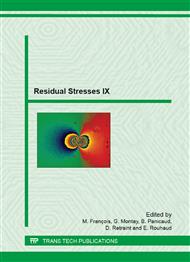p.283
p.289
p.295
p.301
p.307
p.313
p.319
p.325
p.331
Investigation of Influence Factors on Residual Stress Determination within Coated Surfaces in Consideration of the Differential and Integral Method
Abstract:
To improve the surface behavior of metal structures, like wear-and heat resistance or hardness, often thermally sprayed ceramic coatings are applied. A modern technology to realize dense layers is the High Velocity Oxygen Fuel (HVOF) technique. The deposition process and necessary pretreatments can cause high residual stresses within the coating and the substrate. While tensile stresses in the brittle coating may cause cracks, compressive stress states can even improve the materials behavior. To guarantee high product quality, it is necessary to know exactly the occurring residual stresses in the metal-ceramic hybrid system. A very common measurement technique is the incremental hole drilling (IHD) method. To determine the residual stresses out of IHD measurements the differential method (DM) or integral method (IM) can be used. To investigate the influence of interfacial layers, nonlinear stresses, cracking, anisotropy, variation of coating thickness and calculation formalisms several FEM models have been build, while case sensitive calibration was used for the coated systems.
Info:
Periodical:
Pages:
307-312
Citation:
Online since:
August 2014
Permissions:
Share:
Citation:


